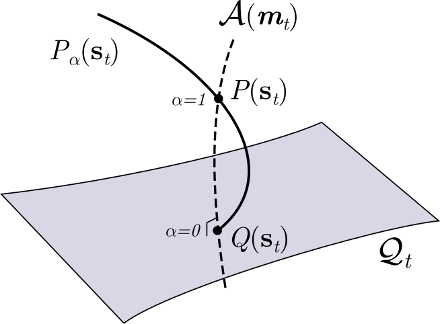
DIMENSIVE
Data-driven Inference of Models from Embodied Neural Systems In Vertebrate Experiments


A major challenge in cognitive neuroscience is to understand how behaviour arises from the dynamical interaction of an organism’s nervous system, its body, and its environment. Understanding embodied neural activity involves the resolution of various conceptual, technical and methodological issues in explaining how living organisms self-organize at many levels (from neural bio-chemistry to behaviour and learning). Currently, two important obstacles hinder this endeavour: the difficulties in recording neural activity in behaving animals, and the lack of mathematical tools to characterize the complex brain-body-environment interactions in living organisms. This project addresses these limits by implementing an interdisciplinary combination of novel animal behaviour neuroimaging setups and large-scale statistical methods, with the goal of recording and modelling whole-brain activity of locomoting vertebrates. We will study fictively swimming larval zebrafish during active behaviour in a pioneering experimental setup, recording neural activity utilizing light-sheet microscopy for calcium imaging in different virtual reality scenarios involving sensorimotor manipulations. In this setup, we will collect data from the distributed neural circuits that integrate sensory signals from the environment (exafferent input) and their own movements (reafferent input), as well as plastic processes of habituation to new sensorimotor contingencies. From this data, we will infer large-scale generative models (i.e. models capable of yielding synthetic data resembling the studied phenomena) of embodied neural circuits by complementing dynamical models and techniques from statistical mechanics with innovative information theoretic and Bayesian inference methods and approximations for very large systems in non-equilibrium and non-stationary conditions.
Simulation data of asymmetric kinetic Ising models near a ferromagnetic phase transition (download link).
This data can be used for generating the results in Aguilera, M, Moosavi, SA & Shimazaki H (2021). A unifying framework for mean-field theories of asymmetric kinetic Ising systems. Nature Communications 12:1197, as well ass for exploring ferromagnetic phase transitions in the asymmetric Sherrington-Kirkpatrick model
In this new paper, published by Miguel Aguilera, Amin Moosavi and Hideaki Shimazaki in Nature Communications, we study and unify different kinetic mean-field methods in Ising models with the objective of developing tools for studying large data-sets from networks of neurons in non-equilibrium conditions and near critical and maximally fluctuating regimes. We propose a framework that integrates previous methods under an information geometric perspective. This framework also also allows us to propose new methods under atypical assuptions for mean-field methods.
The University of Sussex’s Media Relations team has been so kind to write this nice piece on our paper, describing the importance developing methods for studying and modelling the activity of neurons in non-equilibrium conditions and near the edge of chaos.
Aguilera, M, Moosavi, SA & Shimazaki H (2021). A unifying framework for mean-field theories of asymmetric kinetic Ising systems. Nature Communications 12:1197; https://doi.org/10.1038/s41467-021-20890
Abstract
Kinetic Ising models are powerful tools for studying the non-equilibrium dynamics of complex systems. As their behavior is not tractable for large networks, many mean-field methods have been proposed for their analysis, each based on unique assumptions about the system’s temporal evolution. This disparity of approaches makes it challenging to systematically advance mean-field methods beyond previous contributions. Here, we propose a unifying framework for mean-field theories of asymmetric kinetic Ising systems from an information geometry perspective. The framework is built on Plefka expansions of a system around a simplified model obtained by an orthogonal projection to a sub-manifold of tractable probability distributions. This view not only unifies previous methods but also allows us to develop novel methods that, in contrast with traditional approaches, preserve the system’s correlations. We show that these new methods can outperform previous ones in predicting and assessing network properties near maximally fluctuating regimes.
In this new paper, published by Miguel Aguilera and Ezequiel Di Paolo in Neuroscience & Biobehavioral Reviews, we review the link of self-organized criticality and integrated information with ideas about soft assembly in neural and cognitive process. Studying the properties of power-law scaling processes as a in indicator of properties like soft-assembly, self-organization or interaction-dominant-dynamics is a suggestive approach for the understanding of cognitive process from a complex systems perspective. However, critics have suggested that these approaches operate mostly at the level of analogy or metaphor between real phenomena and idealized toy models. We suggest that this issue can be resolved by exploring what specific kinds of criticality we should expect from cognitive agents, and exploring a particular type of criticality related with integrated information theory, as a a system’s susceptibility to changes in its own integration (Aguilera & Di Paolo, 2019). We find that identifying this critical integration is more informative than power-law measures about the underlying processes of a system (e.g. agent-environment asymmetries, robust of sensorimotor interaction).
Aguilera, M & Di Paolo, EA (2021). Critical integration in neural and cognitive systems: Beyond power-law scaling as the hallmark of soft assembly. Neuroscience & Biobehavioral Reviews 123; https://doi.org/10.1016/j.neubiorev.2021.01.009
Abstract
Inspired by models of self-organized criticality, a family of measures quantifies long-range correlations in neural and behavioral activity in the form of self-similar (e.g., power-law scaled) patterns across a range of scales. Long-range correlations are often taken as evidence that a system is near a critical transition, suggesting interaction-dominant, softly assembled relations between its parts. Psychologists and neuroscientists frequently use power-law scaling as evidence of critical regimes and soft assembly in neural and cognitive activity. Critics, however, argue that this methodology operates at most at the level of an analogy between cognitive and other natural phenomena. This is because power-laws do not provide information about a particular system’s organization or what makes it specifically cognitive. We respond to this criticism using recent work in Integrated Information Theory. We propose a more principled understanding of criticality as a system’s susceptibility to changes in its own integration, a property cognitive agents are expected to manifest. We contrast critical integration with power-law measures and find the former more informative about the underlying processes.